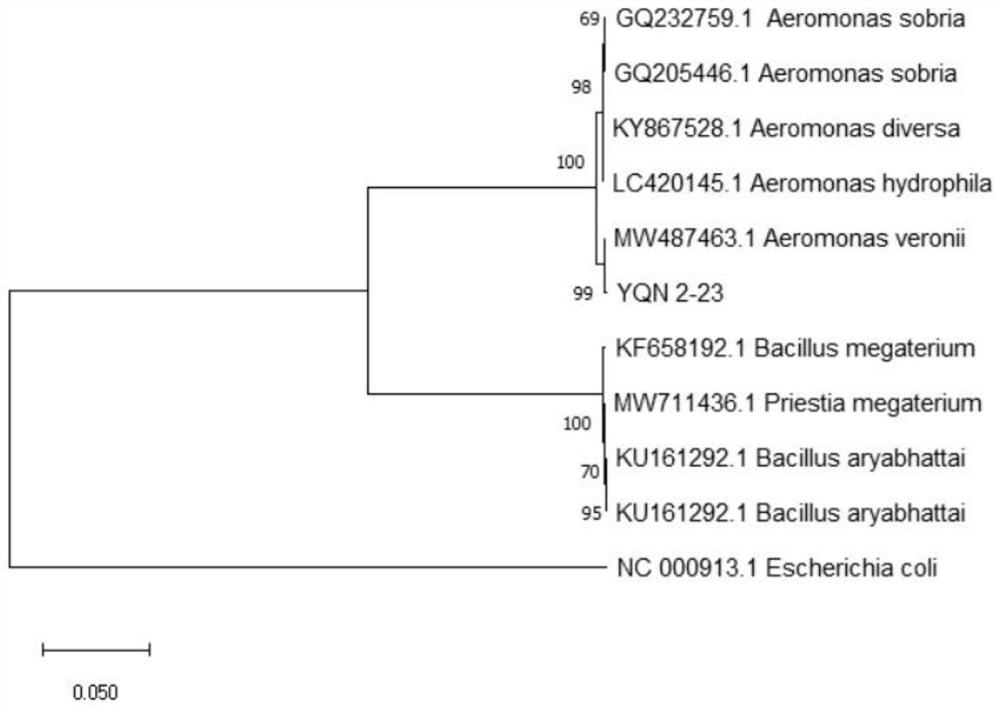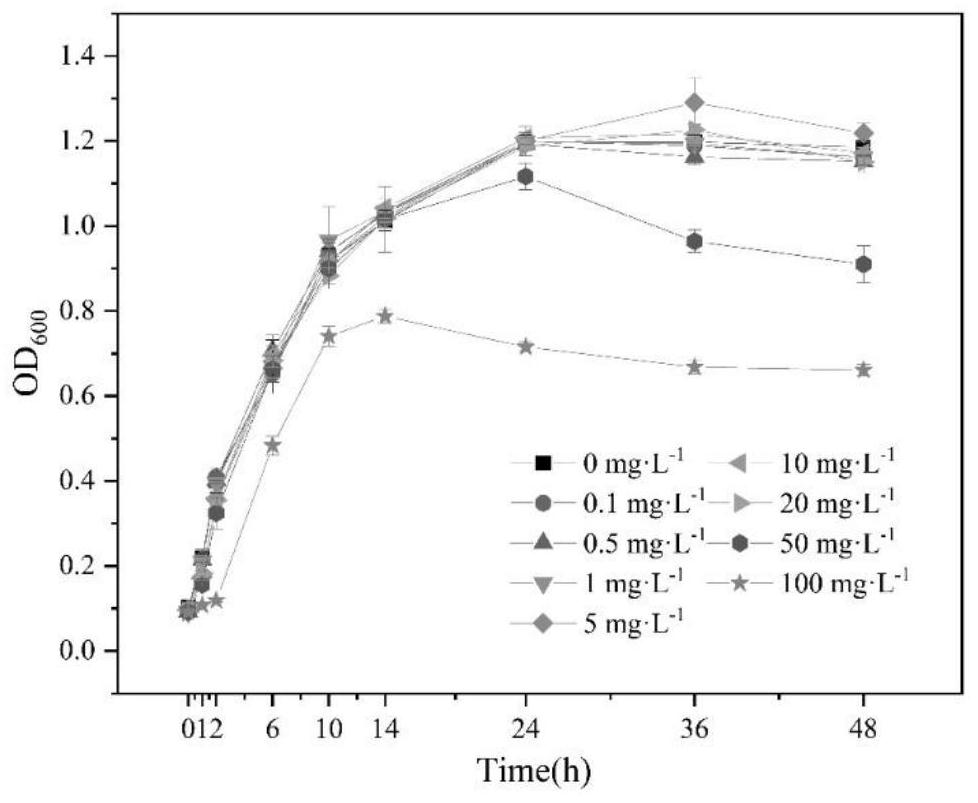Cadmium-resistant strain, method for constructing symbiont with microalgae and application of symbiont
A technology of symbionts and strains, which is applied in the field of cadmium-resistant strains and the construction of symbionts with microalgae, can solve problems such as limited tolerance of heavy metals, and achieve the effect of improving the removal effect.
- Summary
- Abstract
- Description
- Claims
- Application Information
AI Technical Summary
Problems solved by technology
Method used
Image
Examples
Embodiment 1
[0027] Screening, purification and identification of cadmium-resistant bacteria
[0028] 1. Screening: Obtain fresh soil from the farmland near the lead-zinc-silver mining community in Qixia District, Nanjing, take 10g of fresh farmland soil sample and add it to a conical flask of 100mL sterile water, at 30℃, 180r·min -1 Condition, oscillate continuously for 12h and then stand for 1h;
[0029] 2. Purification: Take 100 μL of bacterial supernatant and spread it on a Cd-containing LB plate, place it in a constant temperature incubator for cultivation, and purify the grown single colony by streaking;
[0030] 3. Morphology and physiological characteristics analysis of the obtained strains:
[0031] (1) The morphology was observed by scanning electron microscope, and the specific steps were as follows: inoculate the obtained cadmium-resistant strains in LB broth medium, 30°C for 180r·min -1 After culturing for 24 hours, the bacterial cells were collected at 6000 rpm, washed 2-3 ...
Embodiment 2
[0048] Determination of Cd tolerance and removal ability of strain 2-23:
[0049] (1) The cadmium-resistant strains were inoculated into LB medium, and cultured in a shaker at 30° C. and 180 r / min for 24 h for activation. The activated bacteria were inoculated with Cd concentrations of 0, 5, 10, 20, 50 and 100 mg·L -1 100mL of LB medium was placed in a shaker for cultivation, and its initial OD 600 The values are all around 0.1.
[0050] (2) Use a microplate reader to measure OD at 0, 1, 2, 6, 10, 14, 24, 36, and 48h of culture 600 value to construct a bacterial growth curve.
[0051] (3) The half-effect concentration EC50 value was used to express the toxicity of Cd to bacteria.
[0052] (4) Using the sigmoid dose-response curve equation to fit the OD of the strain grown at different concentrations for 24h 600 value, and then calculate the EC50 value of Cd on bacteria.
[0053] (5) The bacterial supernatant was collected at 0, 1, 2, 6, 10, 14, 24, 36, and 48 h, and th...
Embodiment 3
[0059] Construction of Phaeodactylum tricornutum-strain 2-23 algal-bacterial symbionts and Cd removal:
[0060] 1. Bacterial and Microalgae Suspension
[0061] (1) Cultivate Phaeodactylum tricornutum to logarithmic growth phase, centrifuge and discard the supernatant under centrifugal force of 8000g, wash 2-3 times with f / 2+Si, and collect the sediment in fresh sterile f / 2+ In Si, the microalgae suspension was prepared after mixing.
[0062] (2) Cultivate strains 2-23 to logarithmic growth phase, centrifuge and discard the supernatant under the condition of centrifugal force of 6000 rpm, wash 2-3 times with f / 2+Si, and collect the sediment in fresh sterile f / In 2+Si, the bacterial suspension was prepared after mixing.
[0063] 2. Proportion of microalgae and bacterial cells
[0064] (1) The wavelength of the OD value of the microalgae suspension was measured at 450 nm, and the number of cells in 1 mL of algal solution was calculated using the relationship between OD and th...
PUM
| Property | Measurement | Unit |
|---|---|---|
| wavelength | aaaaa | aaaaa |
| wavelength | aaaaa | aaaaa |
Abstract
Description
Claims
Application Information
 Login to View More
Login to View More - R&D
- Intellectual Property
- Life Sciences
- Materials
- Tech Scout
- Unparalleled Data Quality
- Higher Quality Content
- 60% Fewer Hallucinations
Browse by: Latest US Patents, China's latest patents, Technical Efficacy Thesaurus, Application Domain, Technology Topic, Popular Technical Reports.
© 2025 PatSnap. All rights reserved.Legal|Privacy policy|Modern Slavery Act Transparency Statement|Sitemap|About US| Contact US: help@patsnap.com



